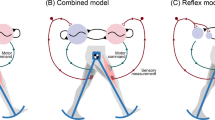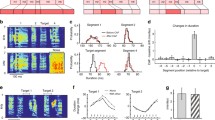Abstract
The paper investigates the ability of a sequential neural network to model the time-keeping function (fundamental frequency oscillation) of a central pattern generator for locomotion. The intention is not to strive for biological fidelity, but rather to ensure that the network obeys the organisational and operational principles of central pattern generators developed through empirical research. The timing function serves to produce the underlying locomotor rhythm which can be transformed by nonlinear static shaping functions to construct the necessary locomotor activation patterns. Using two levels of tonic activations in the form of a step increase, a network consisting of nine processing units was successfully trained to output both sine and cosine waveforms, whose frequencies were modified in response to the level of input activation. The network's ability to generalise was demonstrated by appropriately scaling the frequency of oscillation in response to a range of input amplitudes, both within and outside the values on which it was trained. A notable and fortunate result was the model's failure to oscillate in the absence of input activation, which is a necessary property of the CPG model. It was further demonstrated that the oscillation frequency of the output waveforms exhibited both a high temporal stability and a very low sensitivity to input noise. The results indicate that the sequential neural network is a suitable candidate to model the time-keeping functions of the central pattern generator for locomotion.
Similar content being viewed by others
References
Armstrong, D. M. (1988): ‘The supraspinal control of mammalian locomotion,’J. Physiol.,405, pp. 1–37
Bardakjian, B. L., El-Sharkawy, T. Y., andDiamant, N. E. (1983): ‘On a population of labile synthesized relaxation oscillators,’IEEE Trans.,BME-30, pp. 696–701
Delcomyn, F. (1980): ‘Neural basis of rhythmic behaviour in animals,’Science,210, pp. 492–498
Grillner, S., Wallen, P., Brodin, L., andLasner, A. (1991): ‘Neuronal network generating locomotor behavior in lamprey: circuitry, transmitters, membrane properties, and simulation,’Ann. Rev. Neurosci.,14, pp. 169–199
Grillner, S., andDubuc, R. (1988): ‘Control of locomotion in vertebrates: spinal and supraspinal mechanism’in Waxman, S. G. (Ed.): ‘Advances in neurology. Vol. 47. Functional recovery in neurological disease’ (Raven Press, New York) pp. 425–453
Grillner, S. (1985): ‘Neurobiological bases of rhythmic motor acts in vertebrates,’Science,228, pp. 143–149
Hertz, J., Krogh, A., andPalmer, R. G. (1991): ‘Introduction to the theory of neural computation’ (Addison-Wesley Publishing Company, Redwood, Calfornia)
Jordan, M. I. (1986): ‘Serial order: a parallel distributed processing approach.’ University of California at San Diego, Institute for Cognitive Science Technical Report 8604
Patla, A. E., Calvert, T. W., andStein, R. B. (1985): ‘Model of a pattern generator for locomotion in mammals,’Am. J. Physiol.,248 (Regulatory Integrative Comp. Physiol., 17) R484-R494
Pineda, F. J. (1989): ‘Recurrent backpropagation and the dynamical approach to adaptive neural computation,’Neur. Computat.,1, pp. 161–172
Rumelhart, D. E., Hinton, G. E., andWilliams, R. J. (1986): ‘Learning internal representations by error propagation’in: ‘Parallel distributed processing: explorations in the microstructure of cognition’ (MIT Press/Bradford Books, Cambridge, Massachusetts) pp. 318–364
Sejnowski, T. J., andRosenberg, C. R. (1987): ‘Parallel networks that learn to pronounce English text,’Complex Syst.,1, pp. 145–168
Selverston, A. I. (1993): ‘Modelling neural circuits: what have we learned?’Ann. Rev. Neurosci.,16, pp. 531–546
Shik, M. L., Severin, F. V., andOrlovskii, G. N. (1966): ‘Control of walking and running by means of electrical stimulation of the midbrain,’Biophysics,11, pp. 756–765
Werbos, P. J. (1990): ‘Backpropagation through time: what it does and how to do it,’Proc. IEEE,78, (10), pp. 1550–1560
Williams, R. J., andZipser, D. (1989): ‘Experimental analysis of the real-time-recurrent learning algorithm,’Connect. Sci.,1, pp. 87–111
Author information
Authors and Affiliations
Rights and permissions
About this article
Cite this article
Prentice, S.D., Patla, A.E. & Stacey, D.A. Modelling the time-keeping function of the central pattern generator for locomotion using artificial sequential neural network. Med. Biol. Eng. Comput. 33, 317–322 (1995). https://doi.org/10.1007/BF02510506
Received:
Accepted:
Issue Date:
DOI: https://doi.org/10.1007/BF02510506




